engine coolant JAGUAR S TYPE 1999 1.G Powertrain Manual
[x] Cancel search | Manufacturer: JAGUAR, Model Year: 1999, Model line: S TYPE, Model: JAGUAR S TYPE 1999 1.GPages: 75, PDF Size: 3.4 MB
Page 7 of 75

Glossary
2The following abbreviations are used in this document:
A Ab
bb
br
re
ev
vi
ia
at
ti
io
on
nD
De
es
sc
cr
ri
ip
pt
ti
io
on
n
AAC air assisted (injection) control valve
AAI air assisted injection
ABDC after bottom dead centre
A/C air conditioning
AH amp-hour
API American Petroleum Institute
APP accelerator pedal position (sensor)
ATDC after top dead centre
bank 1 A bank
bank 2 B bank
BBDC before bottom dead centre
BTDC before top dead centre
ûC degree Celsius
CHT cylinder head temperature (sensor)
CKP crankshaft position (sensor)
CMP camshaft position (sensor)
ECT engine coolant temperature (sensor)
EFT engine fuel temperature (sensor)
EGR exhaust gas recirculation
EMS engine management system
EOP engine oil pressure (sensor)
EOT engine oil temperature (sensor)
EVAP evaporative emission
ûF degrees Fahrenheit
HO2 heated oxygen (sensor)
Hz Hertz (cycles per second)
IAT intake air temperature (sensor)
IMT intake manifold tuning (valve)
IP injector pressure (sensor)
JTIS Jaguar Technical Information System
KS knock sensor (sensor)
LH lefthand
MAF mass air flow (sensor)
N/A normally aspirated
NAS North American specification
OBDII on-board diagnostics stage 2
PAS power assisted steering
PCM powertrain control module
PCV positive crankcase ventilation
PWM pulse width modulated
RH righthand
RPM revolutions per minute
SAE Society of Automotive Engineers (USA)
SCP standard corporate protocol
TAC throttle actuator control (module)
TP throttle position (sensor)
VVT variable valve timing
W watts
AJ-V6/AJ28
Page 10 of 75
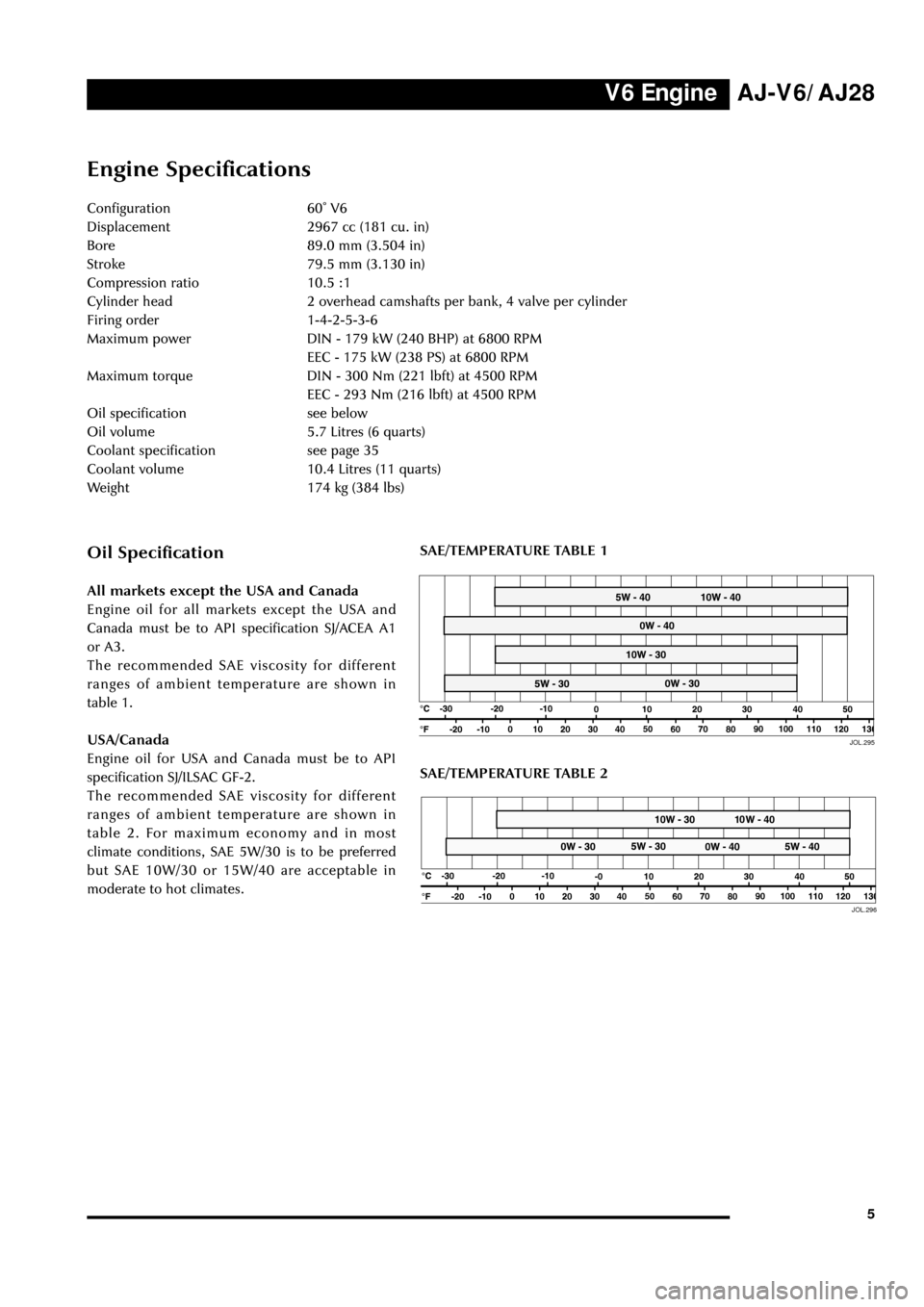
V6 EngineAJ-V6/AJ28
5
Engine Specifications
Configuration 60û V6
Displacement 2967 cc (181 cu. in)
Bore 89.0 mm (3.504 in)
Stroke 79.5 mm (3.130 in)
Compression ratio 10.5 :1
Cylinder head 2 overhead camshafts per bank, 4 valve per cylinder
Firing order 1-4-2-5-3-6
Maximum power DIN - 179 kW (240 BHP) at 6800 RPM
EEC - 175 kW (238 PS) at 6800 RPM
Maximum torque DIN - 300 Nm (221 lbft) at 4500 RPM
EEC - 293 Nm (216 lbft) at 4500 RPM
Oil specification see below
Oil volume 5.7 Litres (6 quarts)
Coolant specification see page 35
Coolant volume 10.4 Litres (11 quarts)
Weight 174 kg (384 lbs)
JOL.29550
50JOL.296
Oil Specification
All markets except the USA and Canada
Engine oil for all markets except the USA and
Canada must be to API specification SJ/ACEA A1
or A3.
The recommended SAE viscosity for different
ranges of ambient temperature are shown in
table 1.
USA/Canada
Engine oil for USA and Canada must be to API
specification SJ/ILSAC GF-2.
The recommended SAE viscosity for different
ranges of ambient temperature are shown in
table 2. For maximum economy and in most
climate conditions, SAE 5W/30 is to be preferred
but SAE 10W/30 or 15W/40 are acceptable in
moderate to hot climates.SAE/TEMPERATURE TABLE 2
SAE/TEMPERATURE TABLE 1
Page 20 of 75
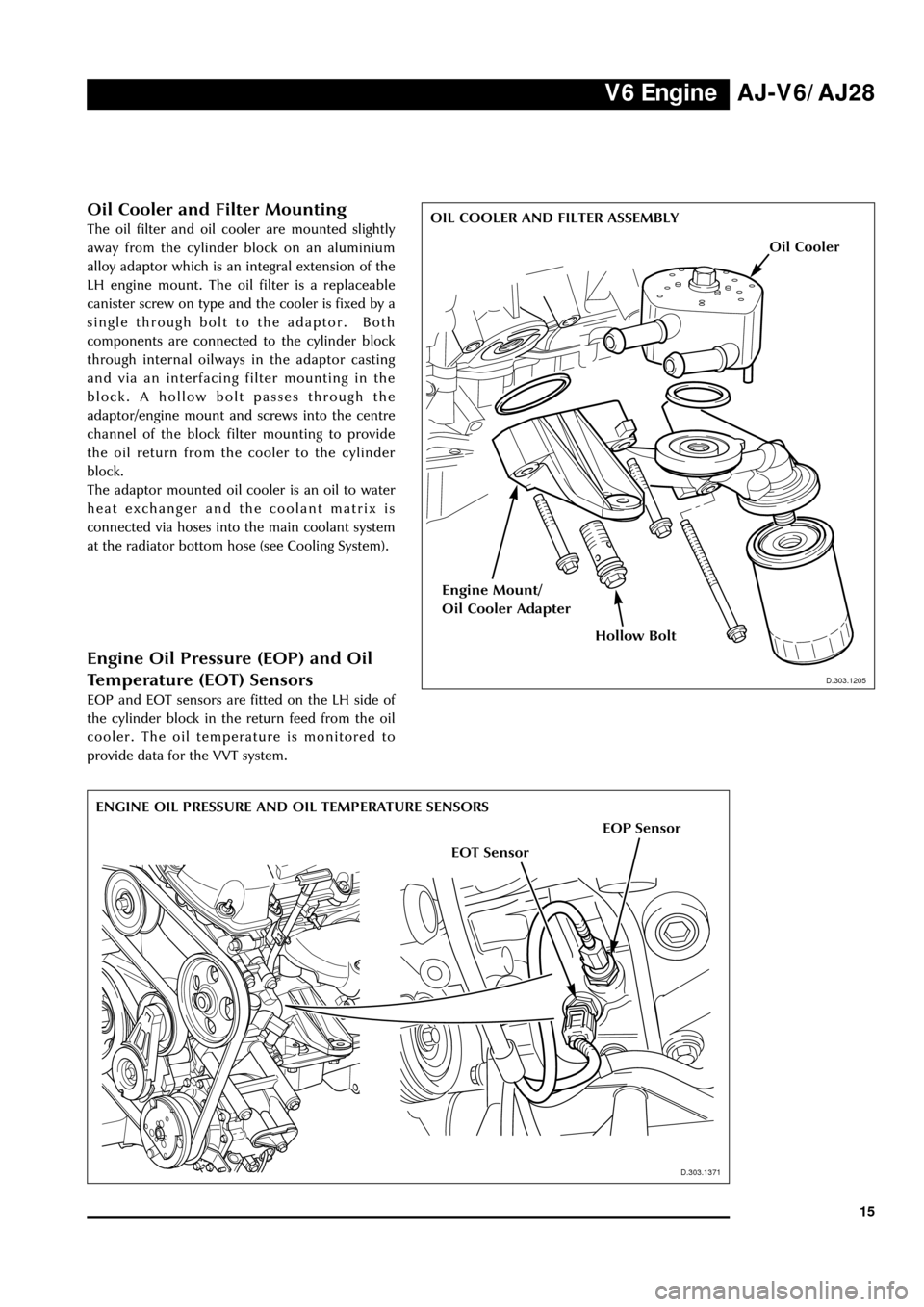
V6 EngineAJ-V6/AJ28
15
Oil Cooler and Filter Mounting
The oil filter and oil cooler are mounted slightly
away from the cylinder block on an aluminium
alloy adaptor which is an integral extension of the
LH engine mount. The oil filter is a replaceable
canister screw on type and the cooler is fixed by a
single through bolt to the adaptor. Both
components are connected to the cylinder block
through internal oilways in the adaptor casting
and via an interfacing filter mounting in the
block. A hollow bolt passes through the
adaptor/engine mount and screws into the centre
channel of the block filter mounting to provide
the oil return from the cooler to the cylinder
block.
The adaptor mounted oil cooler is an oil to water
heat exchanger and the coolant matrix is
connected via hoses into the main coolant system
at the radiator bottom hose (see Cooling System).
ENGINE OIL PRESSURE AND OIL TEMPERATURE SENSORS
D.303.1205
OIL COOLER AND FILTER ASSEMBLY
EOP Sensor
EOT Sensor
D.303.1205
D.303.1371
Engine Oil Pressure (EOP) and Oil
Temperature (EOT) Sensors
EOP and EOT sensors are fitted on the LH side of
the cylinder block in the return feed from the oil
cooler. The oil temperature is monitored to
provide data for the VVT system.
Oil Cooler
Hollow Bolt
Engine Mount/
Oil Cooler Adapter
Page 22 of 75
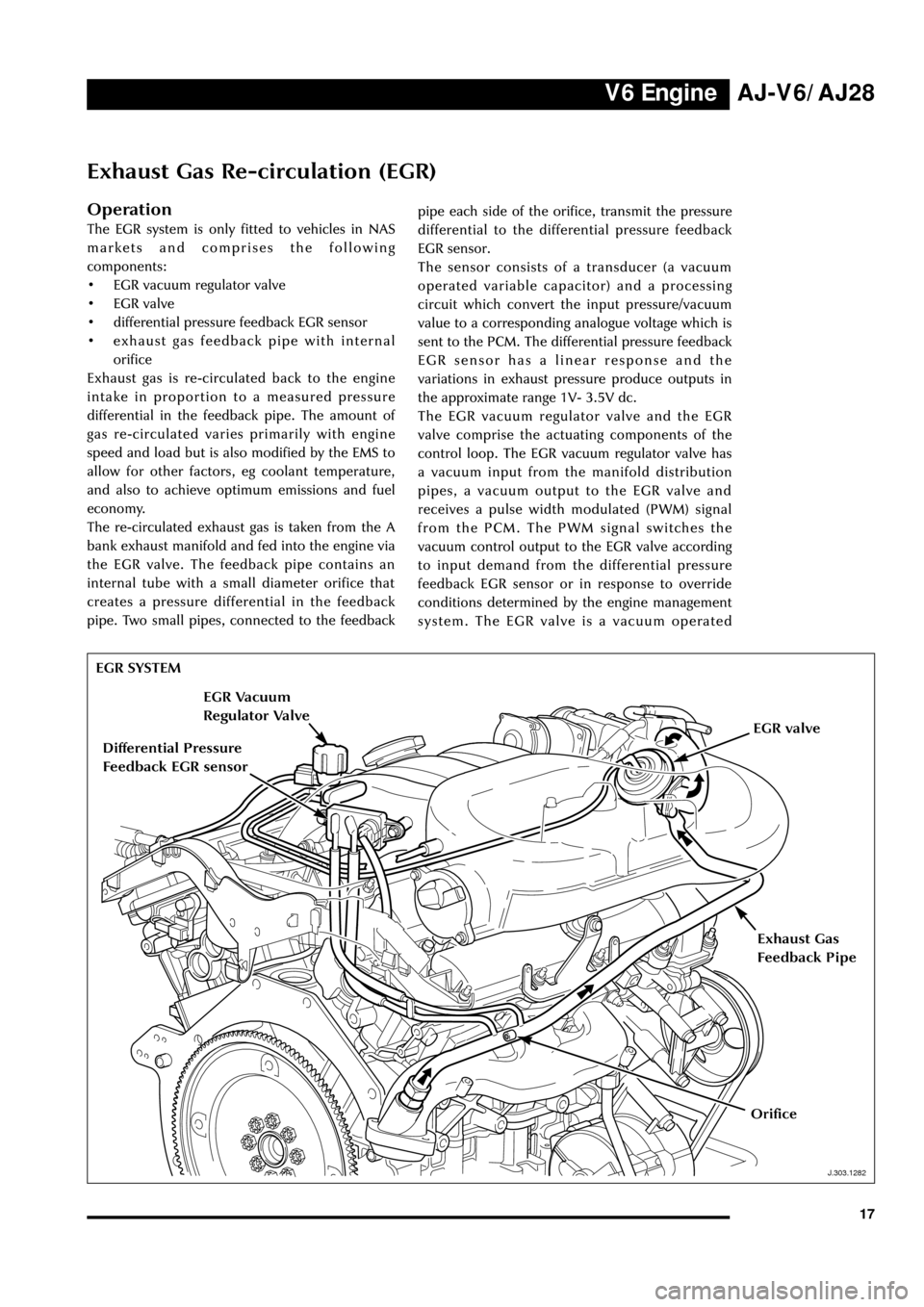
V6 EngineAJ-V6/AJ28
17
Exhaust Gas Re-circulation (EGR)
Operation
The EGR system is only fitted to vehicles in NAS
markets and comprises the following
components:
¥ EGR vacuum regulator valve
¥ EGR valve
¥ differential pressure feedback EGR sensor
¥ exhaust gas feedback pipe with internal
orifice
Exhaust gas is re-circulated back to the engine
intake in proportion to a measured pressure
differential in the feedback pipe. The amount of
gas re-circulated varies primarily with engine
speed and load but is also modified by the EMS to
allow for other factors, eg coolant temperature,
and also to achieve optimum emissions and fuel
economy.
The re-circulated exhaust gas is taken from the A
bank exhaust manifold and fed into the engine via
the EGR valve. The feedback pipe contains an
internal tube with a small diameter orifice that
creates a pressure differential in the feedback
pipe. Two small pipes, connected to the feedbackpipe each side of the orifice, transmit the pressure
differential to the differential pressure feedback
EGR sensor.
The sensor consists of a transducer (a vacuum
operated variable capacitor) and a processing
circuit which convert the input pressure/vacuum
value to a corresponding analogue voltage which is
sent to the PCM. The differential pressure feedback
EGR sensor has a linear response and the
variations in exhaust pressure produce outputs in
the approximate range 1V- 3.5V dc.
The EGR vacuum regulator valve and the EGR
valve comprise the actuating components of the
control loop. The EGR vacuum regulator valve has
a vacuum input from the manifold distribution
pipes, a vacuum output to the EGR valve and
receives a pulse width modulated (PWM) signal
from the PCM. The PWM signal switches the
vacuum control output to the EGR valve according
to input demand from the differential pressure
feedback EGR sensor or in response to override
conditions determined by the engine management
system. The EGR valve is a vacuum operated
EGR SYSTEM
J.303.1282
Exhaust Gas
Feedback Pipe
Differential Pressure
Feedback EGR sensor
EGR Vacuum
Regulator Valve
EGR valve
Orifice
Page 23 of 75

V6 Engine AJ-V6/AJ28
18diaphragm valve with no electrical connections
which opens the EGR feed pipe to the induction
manifold under the EGR vacuum regulator
control.
Where the EGR system is not fitted, a blanking
plate seals the manifold in place of the EGR valve.
Control Conditions
EGR operates over most of the engine speed/load
range but is disabled by the engine management
system under certain conditions:
¥ during engine cranking
¥ until normal operating temperature is
reached
¥ when the diagnostic system registers a failure
which affects the EGR system (eg a faulty
sensor)
¥ during idling to avoid unstable or erratic
running
¥ during wide open throttle operation
¥ when traction control is operative.
While the main control loop is based on feedback
from the differential pressure feedback EGR
sensor, the EGR rate is also modified by other
engine conditions; coolant, ambient and air
charge temperatures, barometric pressure, VVT
cam position and air charge mass. Note also that
the EGR rate increases gradually after it is enabled
on each drive cycle.
Page 36 of 75
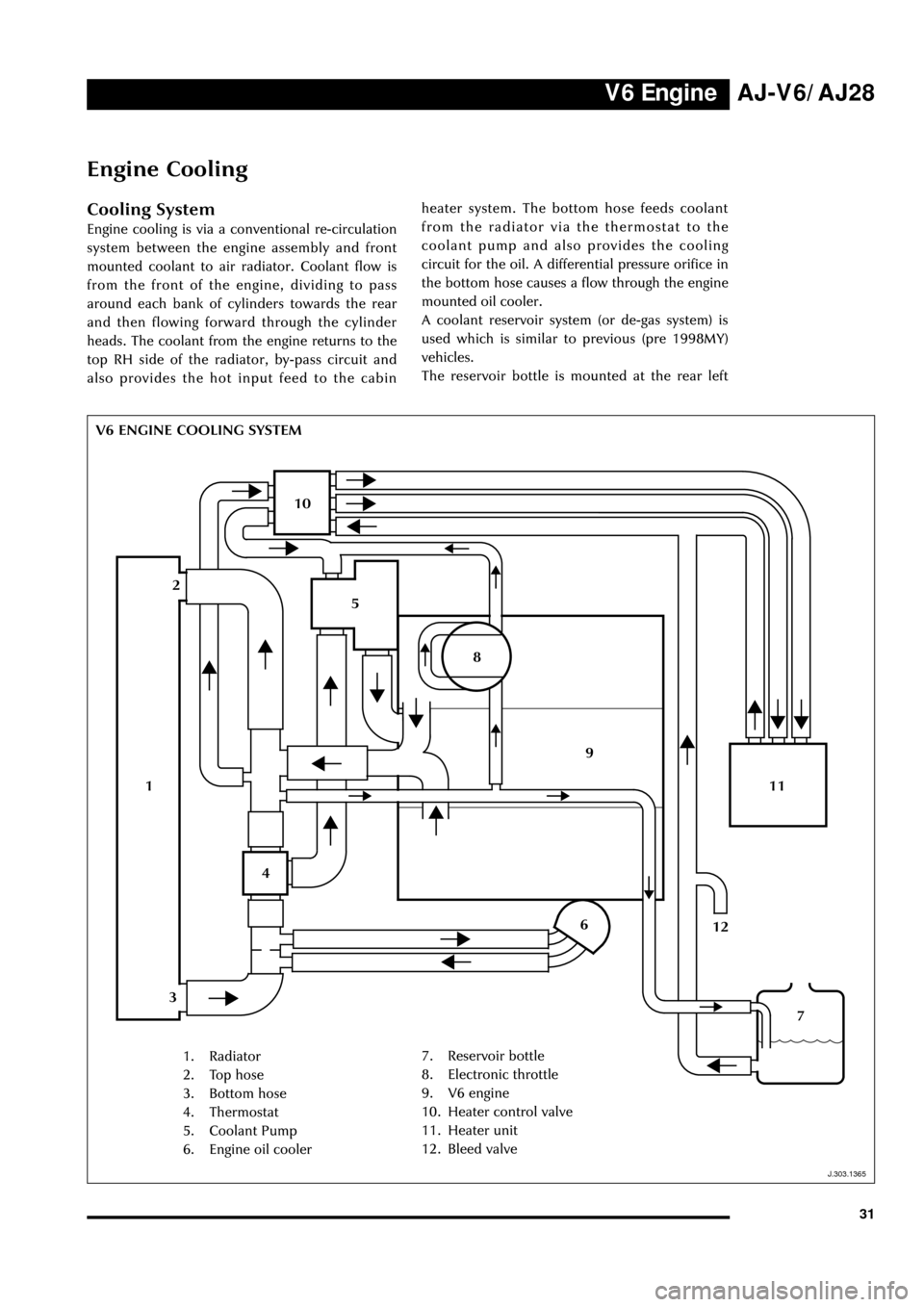
V6 EngineAJ-V6/AJ28
31
J.303.1365
Engine Cooling
Cooling System
Engine cooling is via a conventional re-circulation
system between the engine assembly and front
mounted coolant to air radiator. Coolant flow is
from the front of the engine, dividing to pass
around each bank of cylinders towards the rear
and then flowing forward through the cylinder
heads. The coolant from the engine returns to the
top RH side of the radiator, by-pass circuit and
also provides the hot input feed to the cabin
V6 ENGINE COOLING SYSTEMheater system. The bottom hose feeds coolant
from the radiator via the thermostat to the
coolant pump and also provides the cooling
circuit for the oil. A differential pressure orifice in
the bottom hose causes a flow through the engine
mounted oil cooler.
A coolant reservoir system (or de-gas system) is
used which is similar to previous (pre 1998MY)
vehicles.
The reservoir bottle is mounted at the rear left
1. Radiator
2. Top hose
3. Bottom hose
4. Thermostat
5. Coolant Pump
6. Engine oil cooler7. Reservoir bottle
8. Electronic throttle
9. V6 engine
10. Heater control valve
11. Heater unit
12. Bleed valve
1
10
5
11
9
4
6
2
3
8
12
7
J.303.1365
Page 37 of 75
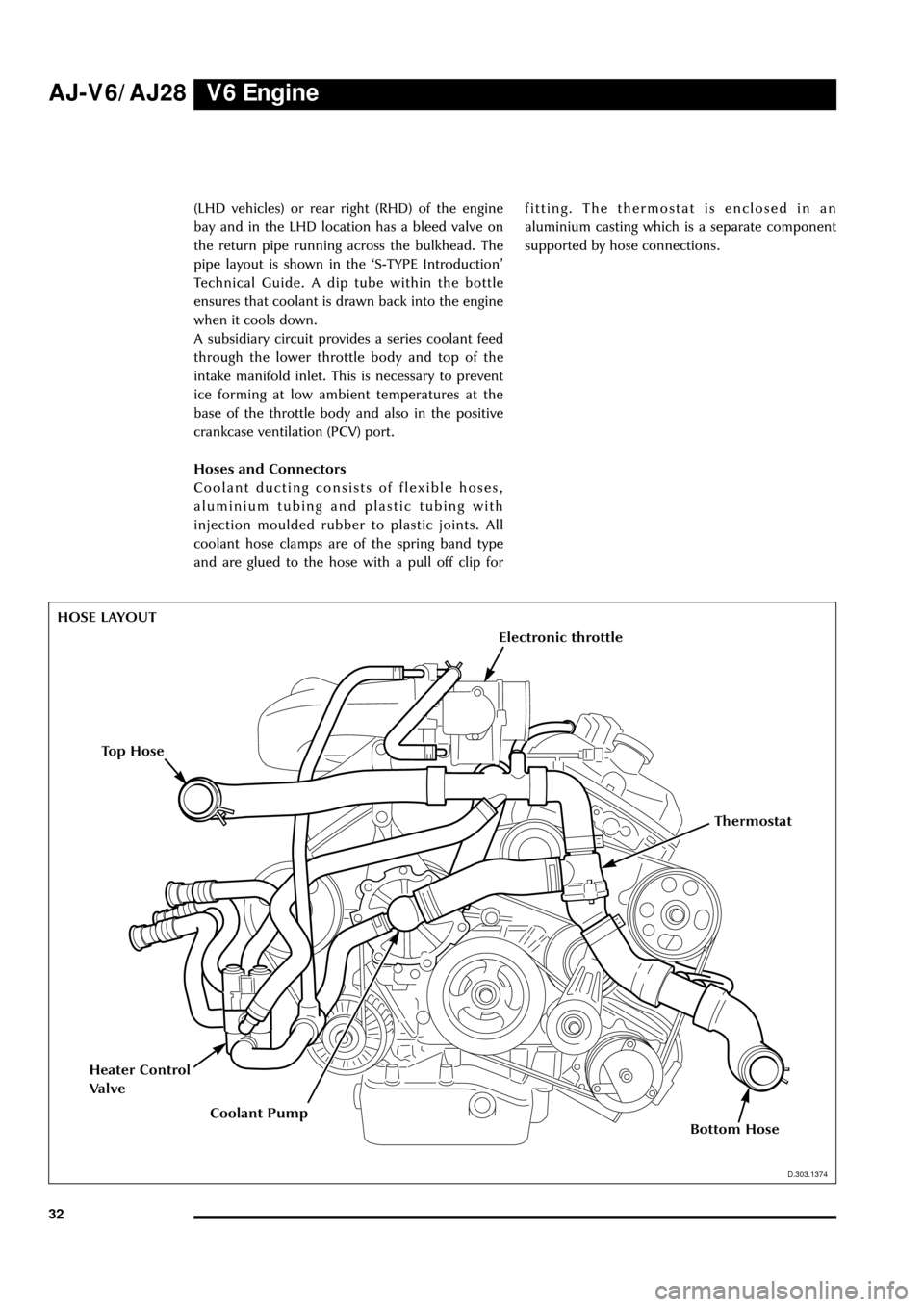
V6 Engine AJ-V6/AJ28
32(LHD vehicles) or rear right (RHD) of the engine
bay and in the LHD location has a bleed valve on
the return pipe running across the bulkhead. The
pipe layout is shown in the ÔS-TYPE IntroductionÕ
Technical Guide. A dip tube within the bottle
ensures that coolant is drawn back into the engine
when it cools down.
A subsidiary circuit provides a series coolant feed
through the lower throttle body and top of the
intake manifold inlet. This is necessary to prevent
ice forming at low ambient temperatures at the
base of the throttle body and also in the positive
crankcase ventilation (PCV) port.
Hoses and Connectors
Coolant ducting consists of flexible hoses,
aluminium tubing and plastic tubing with
injection moulded rubber to plastic joints. All
coolant hose clamps are of the spring band type
and are glued to the hose with a pull off clip for
D.303.1374
HOSE LAYOUT
Electronic throttle
D.303.1374
fitting. The thermostat is enclosed in an
aluminium casting which is a separate component
supported by hose connections.
Top Hose
Bottom Hose
Heater Control
Valve
Thermostat
Coolant Pump
Page 38 of 75
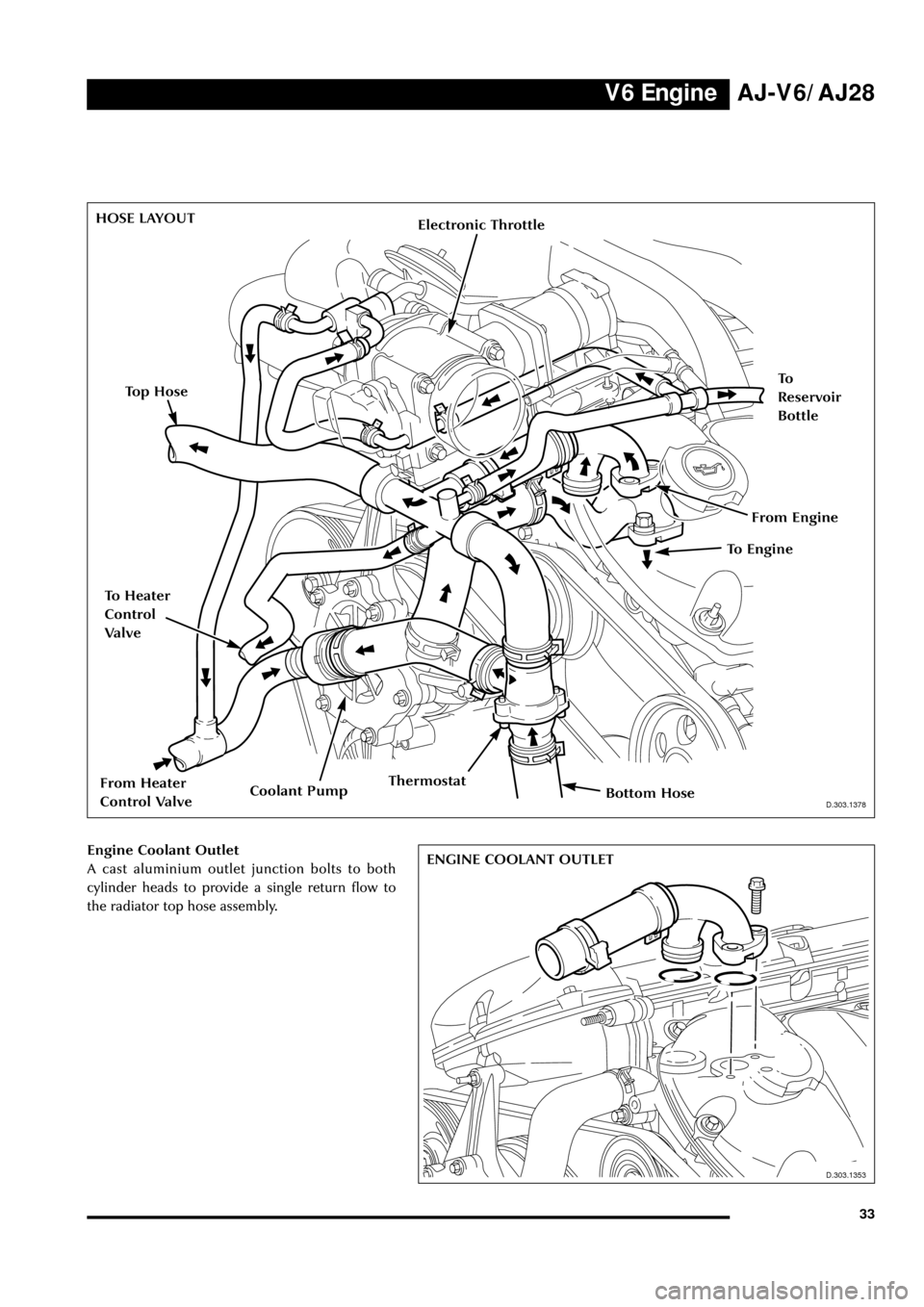
V6 EngineAJ-V6/AJ28
33
J.303.1378
HOSE LAYOUT
D.303.1378
Electronic Throttle
Top Hose
Bottom HoseFrom Heater
Control Valve
To
Reservoir
Bottle
Engine Coolant Outlet
A cast aluminium outlet junction bolts to both
cylinder heads to provide a single return flow to
the radiator top hose assembly.
D.303.1353
ENGINE COOLANT OUTLET
D.303.1353
To Engine
From Engine
To Heater
Control
Valve
ThermostatCoolant Pump
Page 39 of 75
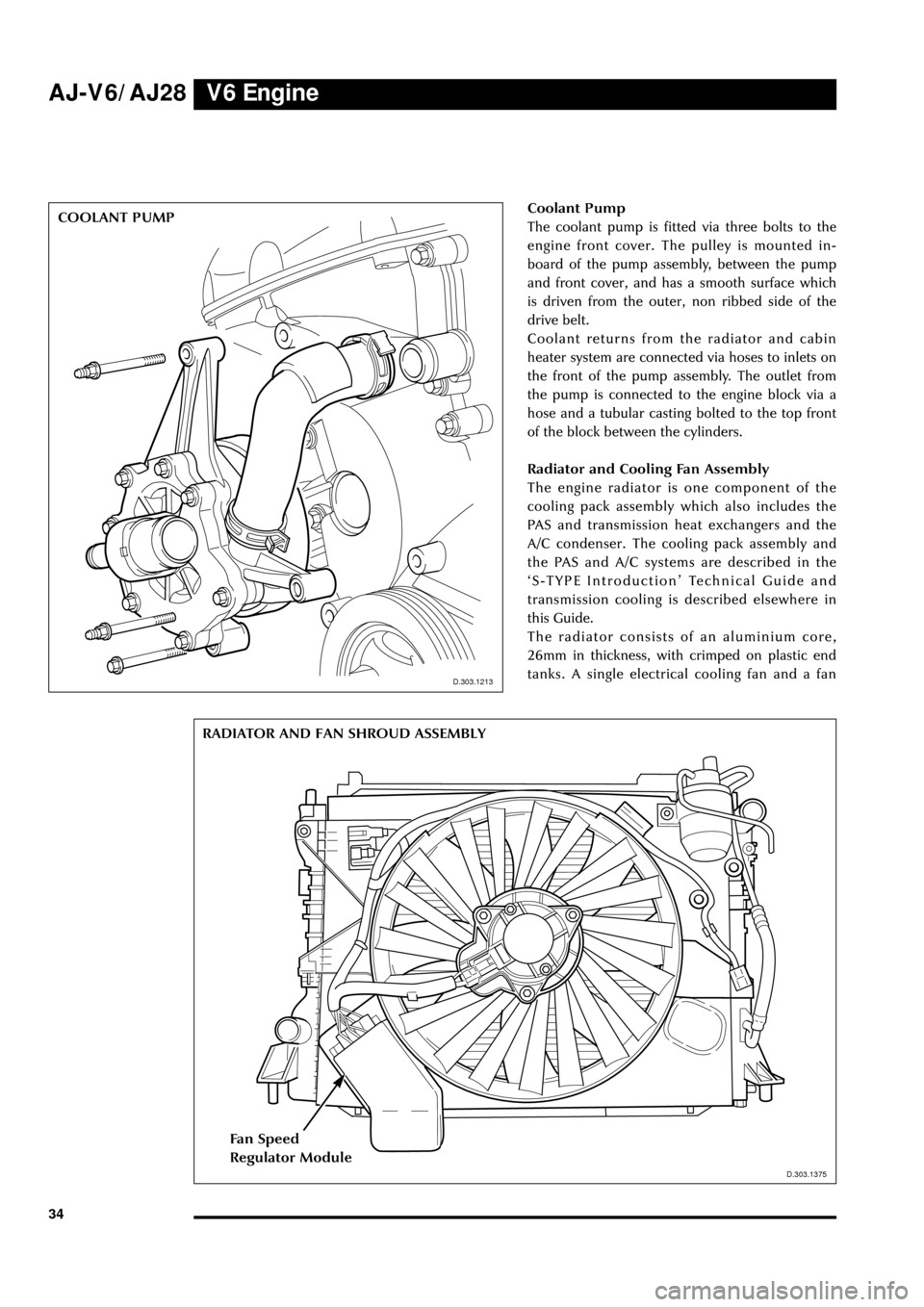
V6 Engine AJ-V6/AJ28
34Coolant Pump
The coolant pump is fitted via three bolts to the
engine front cover. The pulley is mounted in-
board of the pump assembly, between the pump
and front cover, and has a smooth surface which
is driven from the outer, non ribbed side of the
drive belt.
Coolant returns from the radiator and cabin
heater system are connected via hoses to inlets on
the front of the pump assembly. The outlet from
the pump is connected to the engine block via a
hose and a tubular casting bolted to the top front
of the block between the cylinders.
Radiator and Cooling Fan Assembly
The engine radiator is one component of the
cooling pack assembly which also includes the
PAS and transmission heat exchangers and the
A/C condenser. The cooling pack assembly and
the PAS and A/C systems are described in the
ÔS-TYPE IntroductionÕ Technical Guide and
transmission cooling is described elsewhere in
this Guide.
The radiator consists of an aluminium core,
26mm in thickness, with crimped on plastic end
tanks. A single electrical cooling fan and a fan
D.303.1213
COOLANT PUMP
D.303.1213
D.303.1375
RADIATOR AND FAN SHROUD ASSEMBLY
D.303.1375
Fan Speed
Regulator Module
Page 40 of 75
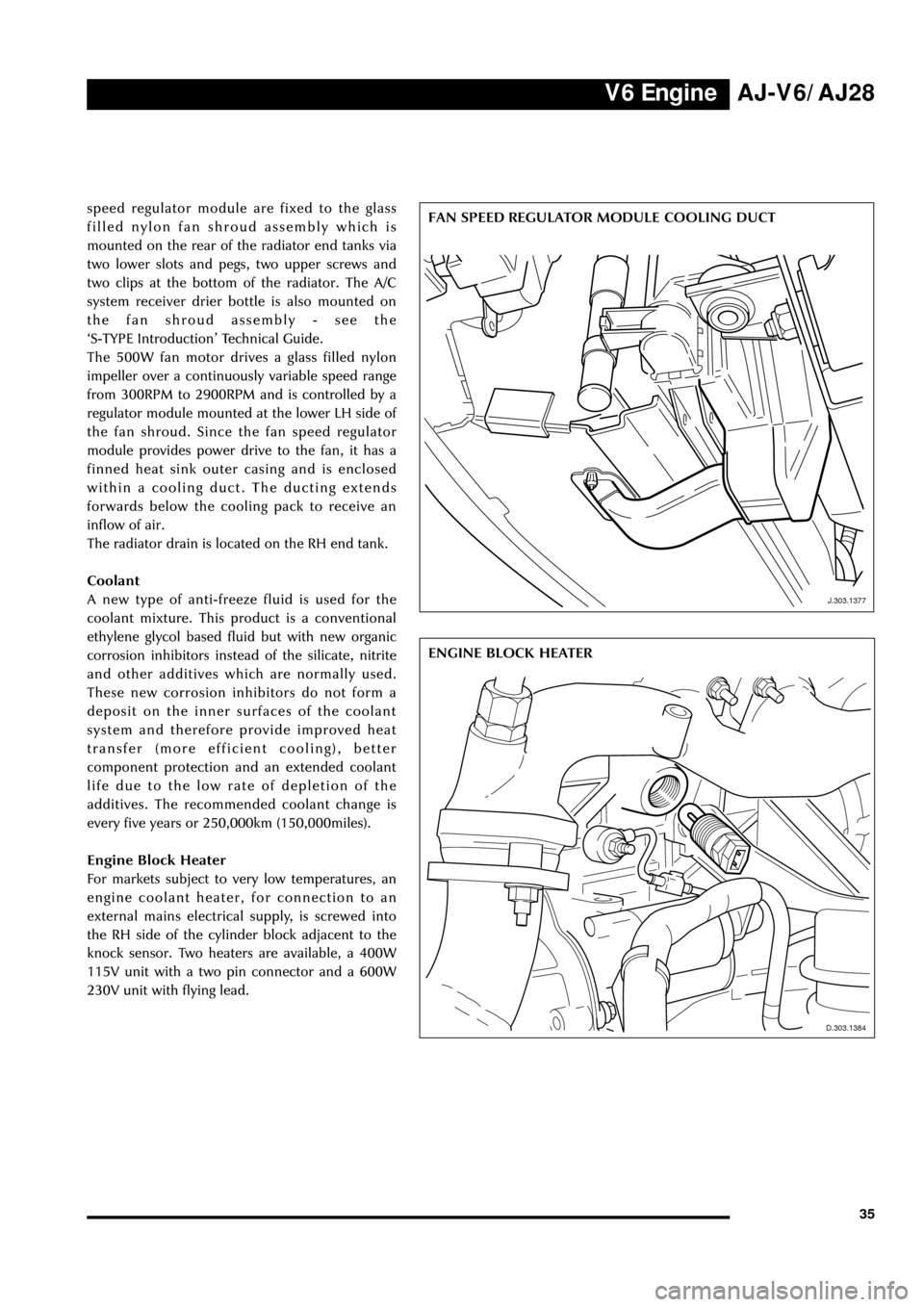
V6 EngineAJ-V6/AJ28
35
J.303.1384
ENGINE BLOCK HEATER
D.303.1384
J.303.1377
FAN SPEED REGULATOR MODULE COOLING DUCT speed regulator module are fixed to the glass
filled nylon fan shroud assembly which is
mounted on the rear of the radiator end tanks via
two lower slots and pegs, two upper screws and
two clips at the bottom of the radiator. The A/C
system receiver drier bottle is also mounted on
the fan shroud assembly - see the
ÔS-TYPE IntroductionÕ Technical Guide.
The 500W fan motor drives a glass filled nylon
impeller over a continuously variable speed range
from 300RPM to 2900RPM and is controlled by a
regulator module mounted at the lower LH side of
the fan shroud. Since the fan speed regulator
module provides power drive to the fan, it has a
finned heat sink outer casing and is enclosed
within a cooling duct. The ducting extends
forwards below the cooling pack to receive an
inflow of air.
The radiator drain is located on the RH end tank.
Coolant
A new type of anti-freeze fluid is used for the
coolant mixture. This product is a conventional
ethylene glycol based fluid but with new organic
corrosion inhibitors instead of the silicate, nitrite
and other additives which are normally used.
These new corrosion inhibitors do not form a
deposit on the inner surfaces of the coolant
system and therefore provide improved heat
transfer (more efficient cooling), better
component protection and an extended coolant
life due to the low rate of depletion of the
additives. The recommended coolant change is
every five years or 250,000km (150,000miles).
Engine Block Heater
For markets subject to very low temperatures, an
engine coolant heater, for connection to an
external mains electrical supply, is screwed into
the RH side of the cylinder block adjacent to the
knock sensor. Two heaters are available, a 400W
115V unit with a two pin connector and a 600W
230V unit with flying lead.
J.303.1377